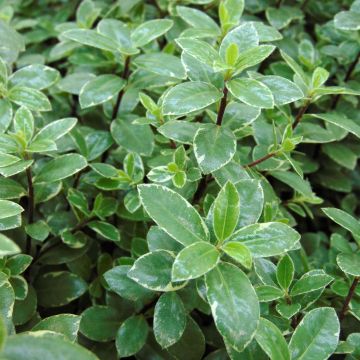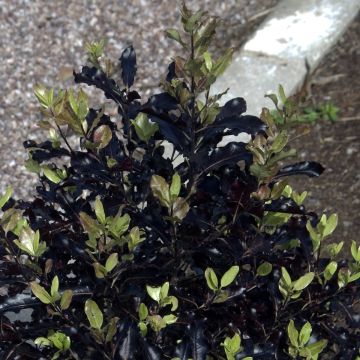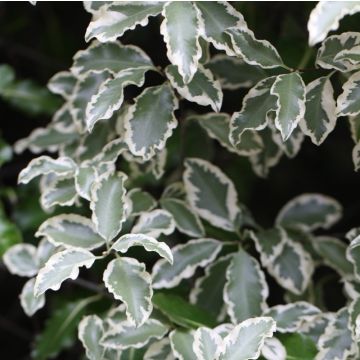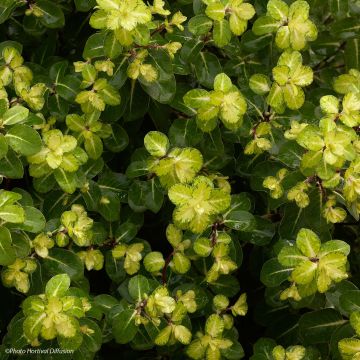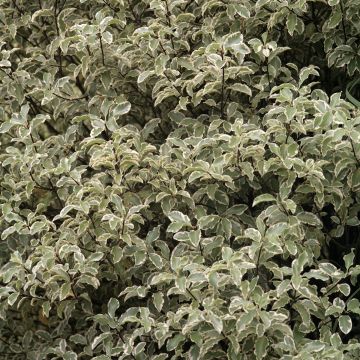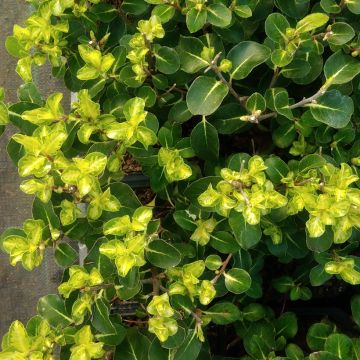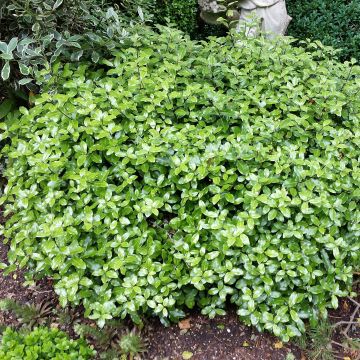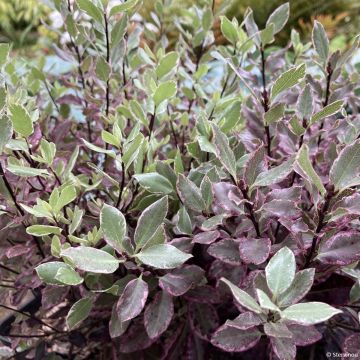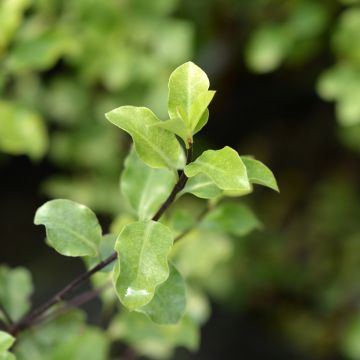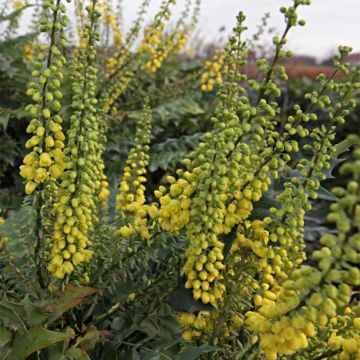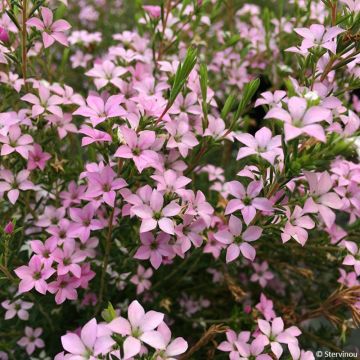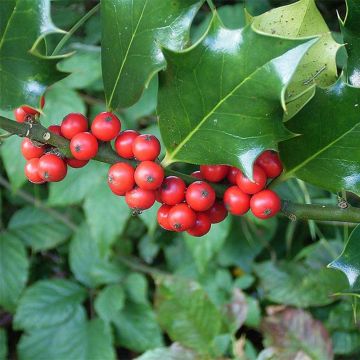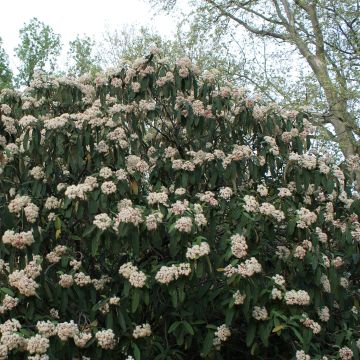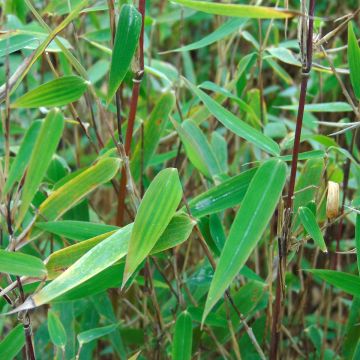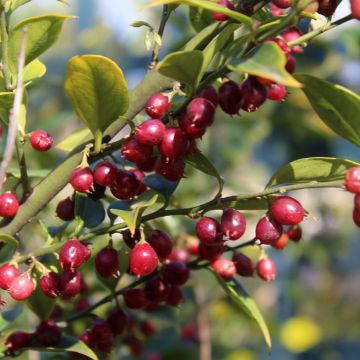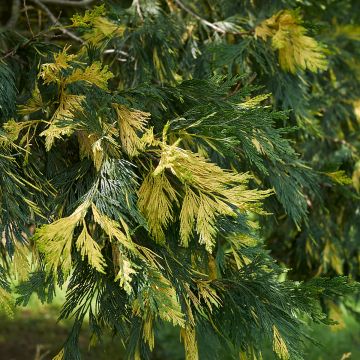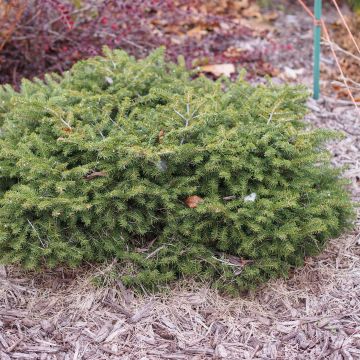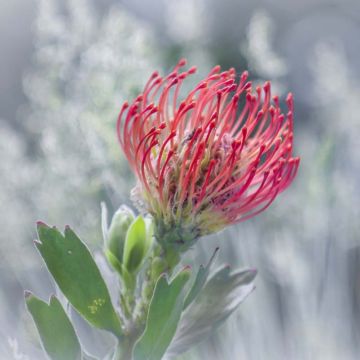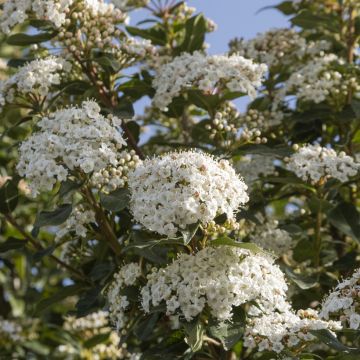

Pittosporum tenuifolium Emerald Dome - Kohuhu
Pittosporum tenuifolium Emerald Dome ('Minpitto')
Tawhiwhi, Kohuhu, Black Matipo, New Zealand Pittosporum
This item cannot be shipped to the selected country
Delivery charge from €5.90
More information
Schedule delivery date,
and select date in basket
This plant carries a 24 months recovery warranty
More information
We guarantee the quality of our plants for a full growing cycle, and will replace at our expense any plant that fails to recover under normal climatic and planting conditions.
From €5.90 for pickup delivery and €6.90 for home delivery
Express home delivery from €8.90.

Does this plant fit my garden?
Set up your Plantfit profile →
Description
Pittosporum tenuifolium Emerald Dome is a recent variety forming, as its name suggests, a true dome of elegant, very dense greenery, devoid of flowering, with a colour that leans towards olive green. This vigorous bush is adorned with pretty evergreen leaves, shiny, elegantly enhanced by a well-defined central vein, of a lighter colour. A plant for mild climates and well-drained dry soil, it is perfect for providing the persistent structure of a large free hedge or a bed. It will thrive in sunny situations, in a dry garden, or in a large pot to be stored in cold climates. Suitable for coastal areas. Does not require pruning!
Pittosporum tenuifolium, also known as small-leaved Pittosporum, is a bush from the Pittosporaceae family. It originates from dry regions located to the east of the Alps in New Zealand. The Emerald Dome variety, obtained in 2012 by the Angevin nursery Minier, stands out with a more graphic, ball-shaped habit, a more vigorous growth, and a lack of flowering. Emerald Dome forms over time (its growth is quite slow) a large, dense evergreen bush, in the shape of a wide cone with a slightly flattened top. At maturity, it will reach an average height of 2.50m (8ft 2in) with a spread of 2m (7ft 6in). Its naturally well-groomed habit and slow growth make pruning completely optional. Its thin black branches further accentuate the elegance of its foliage. They bear persistent, alternate, entire, ovate, thick, very shiny, leathery leaves with slightly undulated edges. They are small, not exceeding 3 to 4cm (1.2 - 1.6in) in length and 1.5 to 2cm (0.6 - 0.8in) in width.
Hardy to -7C°/-10°C, Pittosporum tenuifolium Emerald Dome requires a dry, not too chalky, well-drained soil, a warm, sunny location protected from prevailing winds. It tolerates sea spray well, which allows it to be used without reservation in an informal hedge, in a coastal garden. In mild climates, it can also be planted on a large slope or at the back of a bed. Pair it with Pistacia lentiscus, Olearia, Nandina, rosemary, Grevilleas, Escallonias, or combine it with the silver foliage of Atriplex halimus. A little further from the sea, it will also accompany Oleanders, Elaeagnus, the Pineapple Broom (Cytisus battandieri), or the Russian olive (Elaeagnus angustifolia). In colder regions, it can be planted in a container on a terrace to enjoy its Mediterranean charm.
Report an error about the product description
Pittosporum tenuifolium Emerald Dome - Kohuhu in pictures
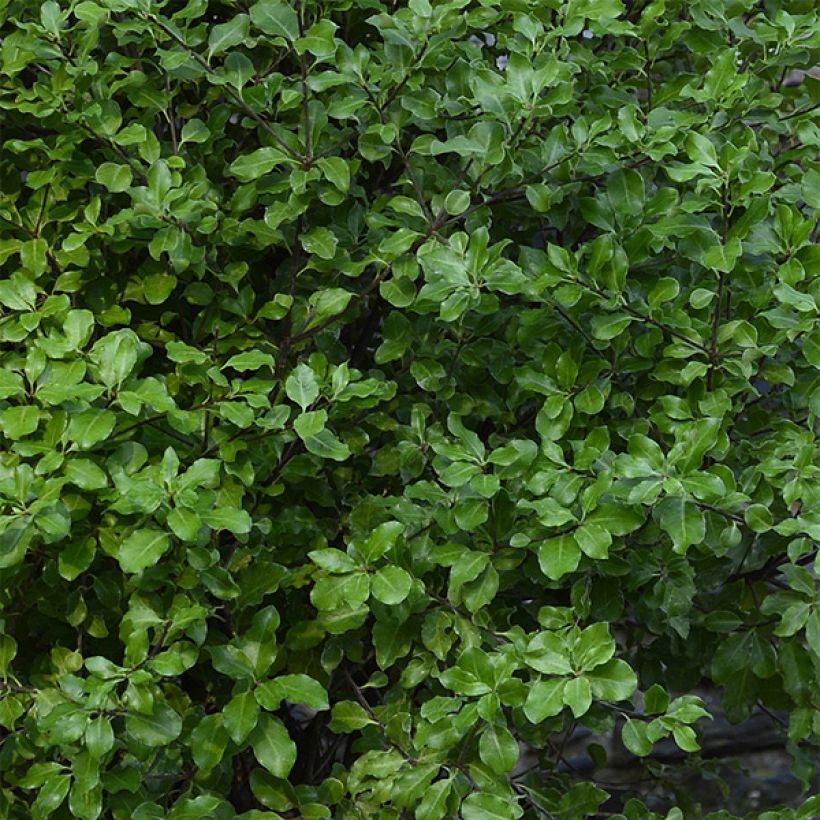

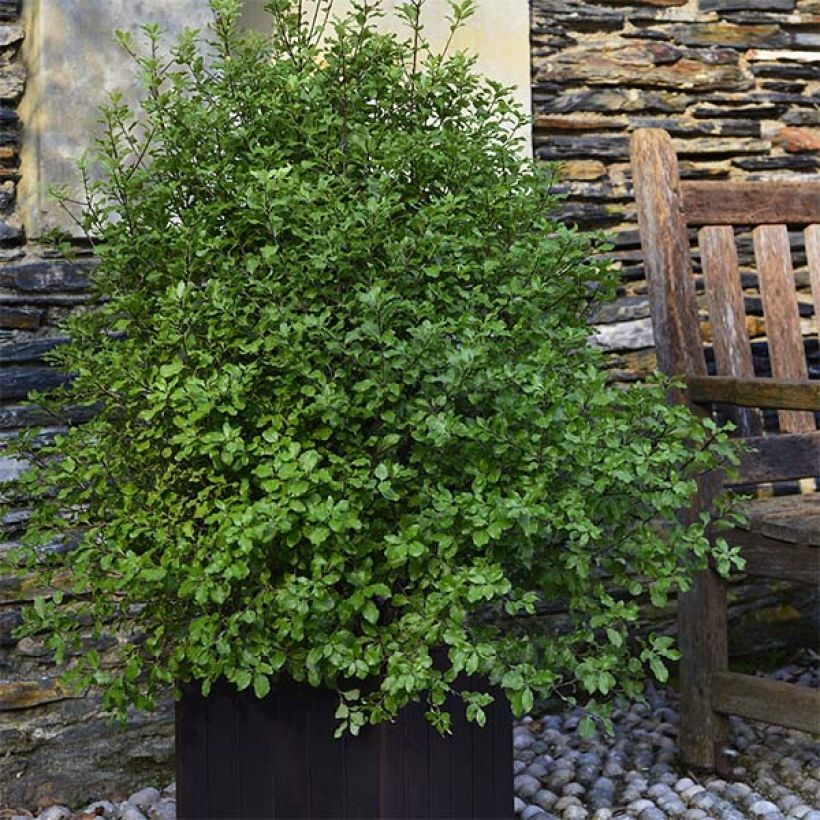

Plant habit
Flowering
Foliage
Botanical data
Pittosporum
tenuifolium
Emerald Dome ('Minpitto')
Pittosporaceae
Tawhiwhi, Kohuhu, Black Matipo, New Zealand Pittosporum
Cultivar or hybrid
Other Pittosporum
Planting and care
Pittosporum tenuifolium is preferably planted in the spring in a cold climate, or in September-October in a mild climate. Plant it in a fertile, dry, not too chalky soil and well-drained. At planting, mix with your garden soil leaf compost and coarse sand at a ratio of 50%. Water your subject generously once or twice a week to promote recovery. Not very hardy (-7°C/-10°C), choose a warm location, in full sun and sheltered from prevailing winds. Immediately mulch the base. Install it along a south-facing wall in regions with mild winters. In colder climates, cover it with a winter fleece or shelter it in a frost-free veranda for the bad season. To help it branch out during the first years of planting, pinch the young shoots. In mature subjects, prune at the end of the season the branches that appear untidy on the clump. It is entirely possible to shape it into a ball or hedge, as it tolerates pruning well.
Planting period
Intended location
Care
-
, onOrder confirmed
Reply from on Promesse de fleurs
Evergreen shrubs
Haven't found what you were looking for?
Hardiness is the lowest winter temperature a plant can endure without suffering serious damage or even dying. However, hardiness is affected by location (a sheltered area, such as a patio), protection (winter cover) and soil type (hardiness is improved by well-drained soil).

Photo Sharing Terms & Conditions
In order to encourage gardeners to interact and share their experiences, Promesse de fleurs offers various media enabling content to be uploaded onto its Site - in particular via the ‘Photo sharing’ module.
The User agrees to refrain from:
- Posting any content that is illegal, prejudicial, insulting, racist, inciteful to hatred, revisionist, contrary to public decency, that infringes on privacy or on the privacy rights of third parties, in particular the publicity rights of persons and goods, intellectual property rights, or the right to privacy.
- Submitting content on behalf of a third party;
- Impersonate the identity of a third party and/or publish any personal information about a third party;
In general, the User undertakes to refrain from any unethical behaviour.
All Content (in particular text, comments, files, images, photos, videos, creative works, etc.), which may be subject to property or intellectual property rights, image or other private rights, shall remain the property of the User, subject to the limited rights granted by the terms of the licence granted by Promesse de fleurs as stated below. Users are at liberty to publish or not to publish such Content on the Site, notably via the ‘Photo Sharing’ facility, and accept that this Content shall be made public and freely accessible, notably on the Internet.
Users further acknowledge, undertake to have ,and guarantee that they hold all necessary rights and permissions to publish such material on the Site, in particular with regard to the legislation in force pertaining to any privacy, property, intellectual property, image, or contractual rights, or rights of any other nature. By publishing such Content on the Site, Users acknowledge accepting full liability as publishers of the Content within the meaning of the law, and grant Promesse de fleurs, free of charge, an inclusive, worldwide licence for the said Content for the entire duration of its publication, including all reproduction, representation, up/downloading, displaying, performing, transmission, and storage rights.
Users also grant permission for their name to be linked to the Content and accept that this link may not always be made available.
By engaging in posting material, Users consent to their Content becoming automatically accessible on the Internet, in particular on other sites and/or blogs and/or web pages of the Promesse de fleurs site, including in particular social pages and the Promesse de fleurs catalogue.
Users may secure the removal of entrusted content free of charge by issuing a simple request via our contact form.
The flowering period indicated on our website applies to countries and regions located in USDA zone 8 (France, the United Kingdom, Ireland, the Netherlands, etc.)
It will vary according to where you live:
- In zones 9 to 10 (Italy, Spain, Greece, etc.), flowering will occur about 2 to 4 weeks earlier.
- In zones 6 to 7 (Germany, Poland, Slovenia, and lower mountainous regions), flowering will be delayed by 2 to 3 weeks.
- In zone 5 (Central Europe, Scandinavia), blooming will be delayed by 3 to 5 weeks.
In temperate climates, pruning of spring-flowering shrubs (forsythia, spireas, etc.) should be done just after flowering.
Pruning of summer-flowering shrubs (Indian Lilac, Perovskia, etc.) can be done in winter or spring.
In cold regions as well as with frost-sensitive plants, avoid pruning too early when severe frosts may still occur.
The planting period indicated on our website applies to countries and regions located in USDA zone 8 (France, United Kingdom, Ireland, Netherlands).
It will vary according to where you live:
- In Mediterranean zones (Marseille, Madrid, Milan, etc.), autumn and winter are the best planting periods.
- In continental zones (Strasbourg, Munich, Vienna, etc.), delay planting by 2 to 3 weeks in spring and bring it forward by 2 to 4 weeks in autumn.
- In mountainous regions (the Alps, Pyrenees, Carpathians, etc.), it is best to plant in late spring (May-June) or late summer (August-September).
The harvesting period indicated on our website applies to countries and regions in USDA zone 8 (France, England, Ireland, the Netherlands).
In colder areas (Scandinavia, Poland, Austria...) fruit and vegetable harvests are likely to be delayed by 3-4 weeks.
In warmer areas (Italy, Spain, Greece, etc.), harvesting will probably take place earlier, depending on weather conditions.
The sowing periods indicated on our website apply to countries and regions within USDA Zone 8 (France, UK, Ireland, Netherlands).
In colder areas (Scandinavia, Poland, Austria...), delay any outdoor sowing by 3-4 weeks, or sow under glass.
In warmer climes (Italy, Spain, Greece, etc.), bring outdoor sowing forward by a few weeks.

































